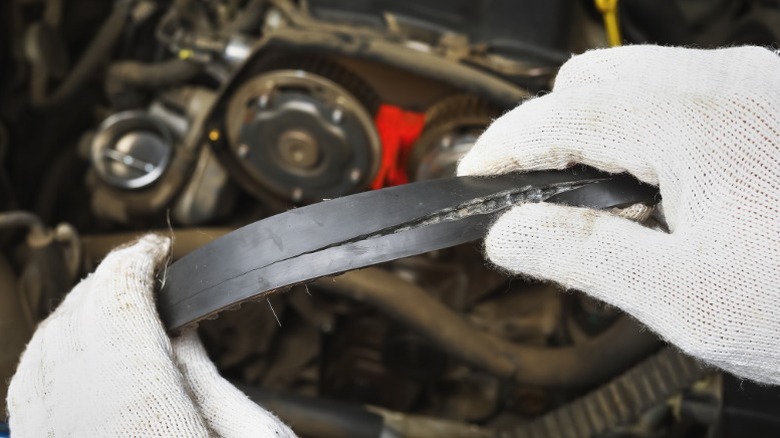Here's What Happens If You Drive With A Broken Serpentine Belt
Your car's serpentine belt or drive belt is an essential part of its anatomy. The belt wraps around the crankshaft pulley and connects to various engine accessories, like the air conditioning compressor, power steering pump, alternator, and more, depending on the vehicle. It's responsible for transferring the crankshaft's rotational power to those engine accessories, allowing your car to do things like create cool fresh air for the cabin and enabling you to use the power steering system. Serpentine belts are usually made of highly-durable rubber and designed to last for between 60,000 and 100,000 miles, depending on the car model and the belt's material. However, these components are not immune to wear and tear, and sometimes, they fail prematurely.
While serpentine belt damage can take many forms, a completely failed drive belt usually translates to one that has broken. If this occurs, you're likely to experience various issues, and you may be wondering if it's safe to drive your vehicle in that condition. While you technically can drive your car with a broken serpentine belt, you should avoid doing so if at all possible. As mentioned, the serpentine belt sends power to various engine accessories, including the power steering pump. If you try to drive your vehicle with a broken drive belt, you'll most likely lose power steering.
If you've never driven a car without power steering before, you may not understand how debilitating it can be to lose that function. Without power steering, turning your wheel will be incredibly difficult. If the belt snaps while you're driving, you could find yourself in an extremely dangerous situation, depending on your current speed and the road. So, what should you do if the belt breaks? As a former professional mechanic, I'll break it down for you.
What to do if your serpentine belt breaks while driving
If your serpentine belt breaks while driving, you're likely going to find yourself in a tricky spot. If you're moving when the belt snaps, you'll probably notice an almost immediate loss of power steering, followed quickly by a loss of cool AC. Additionally, your alternator will be unable to charge your car's battery and supply electrical power as you drive. If your vehicle's serpentine belt is responsible for powering the water pump, you may also notice your engine begins to overheat.
That loss of power steering is the most immediately dangerous issue that you'll likely experience if your serpentine belt breaks. Without power steering, turning your car's steering wheel is extremely difficult. If that occurs at high speeds or while you're driving on a windy road, the consequences could be deadly. The second most dangerous part of a broken serpentine belt is the potential to lose power to the engine water pump. Not all cars rely on the serpentine belt to drive the water pump. However, if your vehicle's water pump is powered by the drive belt, your engine can begin overheating very quickly if the belt breaks. If this occurs, you should decrease your speed and pull over to a secure space as soon as it's safe to do so.
If your serpentine belt happens to break while you're out and about but not actively driving, you should avoid driving until help can arrive. As mentioned, you can drive a car with a broken serpentine belt. However, doing so will likely mean driving without power steering, which can be very dangerous. You'll also risk developing severe engine problems if your serpentine belt powers the water pump, as engine overheating issues are serious and can cause thousands of dollars in damage.
What are some earlier signs of serpentine belt damage?
As mentioned, a broken serpentine belt is a serious problem and constitutes complete belt failure. Fortunately, there are several signs that you need to replace your serpentine belt that should appear before it snaps. It's important to pop your car's hood periodically to perform a basic inspection, including things like checking the oil level, inspecting the engine air filter, and looking at your belts and hoses. Physical damage to the serpentine belt is a strong indicator that you need to replace it and can take the form of things like cracks, glazing, or fraying.
Additionally, you can check the belt's tension. Ideally, you should be able to rotate the belt roughly 90 degrees to the side. If it's too tight or too loose, you may need a replacement or an adjustment. Another potential sign of serpentine or drive belt damage is a squealing or chirping noise coming from the engine bay. These sounds may indicate that the belt is over-worn or improperly tightened, although it can also point to other issues, like a damaged belt tensioner. Other potential signs of serpentine belt damage can include the intermittent function of engine accessories, like the AC compressor or water pump, engine overheating, and the appearance of dashboard warning lights.
While several of the symptoms described above can indicate other problems, you should inspect your serpentine belt if you experience any of them yourself. It's a quick and simple process, and it could help you pinpoint the issue. That said, you should always adhere to your manufacturer's recommendations regarding serpentine belt replacement. You can find this information in your vehicle owner's manual, and following it closely should help you avoid issues like serpentine belt failure.


